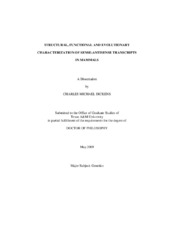| dc.contributor.advisor | Elsik, Christine G. | |
| dc.contributor.advisor | Skow, Loren C. | |
| dc.creator | Dickens, Charles | |
| dc.date.accessioned | 2010-07-15T00:14:02Z | |
| dc.date.accessioned | 2010-07-23T21:45:24Z | |
| dc.date.available | 2010-07-15T00:14:02Z | |
| dc.date.available | 2010-07-23T21:45:24Z | |
| dc.date.created | 2009-05 | |
| dc.date.issued | 2010-07-14 | |
| dc.date.submitted | May 2009 | |
| dc.identifier.uri | https://hdl.handle.net/1969.1/ETD-TAMU-2009-05-772 | |
| dc.description.abstract | Sense-antisense transcripts (SATs) are messenger RNA (mRNA) transcripts that have regions that are complementary to regions of other mRNA transcripts. SATs may play an influential role in the regulation of gene expression. One evolutionary event that has had a dramatic impact on many genomes is the widespread dispersal of repetitive sequences which includes transposable elements (TEs) as well as simple and tandem repeats. Approximately 45% of the human and 37.5% of the mouse genomes are composed of repeats derived from transposable elements. A group of SATs was identified as resulting from transposable elements integrating into the coding strand of some genes and into the template strand of the coding region of other genes. These SATs may add to the complexity of an organism's regulatory network or they may be the result of rather recent TE activities yet to succumb to sequence divergence.
The human, mouse and bovine genomes were analyzed for SATs using publicly available datasets and bioinformatics analysis tools. Each sense-antisense binding region (SABR) was aligned to transposable elements from the RepBase repeat database revealing many SABRs containing TE sequence in a large portion of the sequence. A Gene Ontology analysis on subsets of the data showed enrichments for the functional category of "DNA repair" and the component category "cytoplasm". An analysis of the substitution rates in human and mouse across the 3' UTRs of transcripts containing SABRs at the 5' end of their 3' UTRs showed that the substitution rate in the region of the SABR was lower than compared to the beginning of the 3' UTR. The lower percent GC composition found at the 3' end of the 3' UTRs could be attributed to conserved poly-A signals in this region. | en |
| dc.format.mimetype | application/pdf | |
| dc.language.iso | eng | |
| dc.subject | bioinformatics | en |
| dc.subject | sense-antisense | en |
| dc.title | Structural, Functional and Evolutionary Characterization of Sense-Antisense Transcripts in Mammals | en |
| dc.type | Book | en |
| dc.type | Thesis | en |
| thesis.degree.department | Animal Science | en |
| thesis.degree.discipline | Genetics | en |
| thesis.degree.grantor | Texas A&M University | en |
| thesis.degree.name | Doctor of Philosophy | en |
| thesis.degree.level | Doctoral | en |
| dc.contributor.committeeMember | Womack, James E. | |
| dc.contributor.committeeMember | Adelson, David L. | |
| dc.contributor.committeeMember | Riggs, Penny K. | |
| dc.type.genre | Electronic Dissertation | en |
| dc.type.material | text | en |


